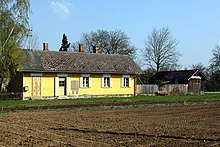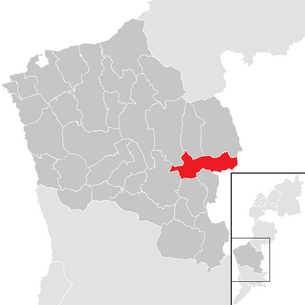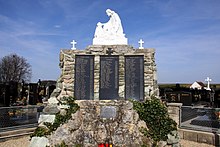Chess village
|
Chess
village of Čajta |
||
|---|---|---|
| coat of arms | Austria map | |
|
|
||
| Basic data | ||
| Country: | Austria | |
| State : | Burgenland | |
| Political District : | Oberwart | |
| License plate : | OW | |
| Surface: | 22.3 km² | |
| Coordinates : | 47 ° 16 ' N , 16 ° 26' E | |
| Height : | 286 m above sea level A. | |
| Residents : | 755 (January 1, 2020) | |
| Population density : | 34 inhabitants per km² | |
| Postcodes : | 7472, 7503 | |
| Community code : | 1 09 22 | |
| NUTS region | AT113 | |
| Address of the municipal administration: |
Schachendorf 218 7472 Schachendorf |
|
| Website: | ||
| politics | ||
| Mayor : | Robert Marlovits ( ÖVP ) | |
|
Municipal Council : ( 2017 ) (15 members) |
||
| Location of the chess village Čajta in the Oberwart district |
||
 The Catholic parish church of St. Martin in Schachendorf |
||
| Source: Municipal data from Statistics Austria | ||
Schachendorf , Croatian Čajta , Hungarian Csajta , is a bilingual community in the Oberwart district in Burgenland in Austria . The share of Burgenland Croats in the total population is 73%, 20% describe themselves as German-speaking. The Burgenland Hungarians make up 5% of the population.
geography
Geographical location
The community is located in southern Burgenland. The localities of the municipality are (residents in brackets as of January 1, 2020):
- Dürnbach im Burgenland (Croatian: Vincjet) (324)
- Chess Village (Hungarian: Csajta, Croatian: Čajta) (431)
Incorporations
On January 1, 1971, the municipalities of Dürnbach in Burgenland, Schachendorf and Schandorf were merged.
history
The first written mention of the village of Schachendorf comes from a document from 1374 in which it is called Cacha. This also leads to today's Croatian name "Cajta", which is probably due to the Hungarian personal name Csejta / Csayte. In 1540 Schachendorf was named Groß-Schachtendorff and a German settlement. Schachendorf was divided into Großschachendorf (Nagy Csajta) and Kleinschachendorf, a small aristocratic settlement.
The war against the Ottomans resulted in mass emigration that began around the time of the Battle of the Krbava Field (1493) and lasted until the Battle of Sisak in 1593. The fleeing Croatians were resettled in devastated areas of land and desolate areas plagued by agricultural crises, where there was a labor shortage due to war and disease.
In the middle of the 16th century, under Franz I. Batthyany , Croats from parts of the Batthyany estate were settled in areas devastated since the Turkish wars. The first Croatian surnames appeared in the land registers of 1548. Nevertheless, fires, uprisings and the furious plague decimated the population, so that in the land register of 1622 the whole village was classified as "devastated".
In the middle of the 17th century, agricultural prices rose rapidly and there were favorable sales opportunities. The Croatian settlers who lasted until the middle of the 16th century and were mainly active on the farm had an advantage. In and around Schachendorf, in particular, optimal, natural conditions were found for growing grain. There was a surplus that could be sold in the surrounding centers (Szombathely, Rechnitz, Güns) and also nationwide. The large Rechitz chute is evidence of this.
Construction of the church began in 1818 and was completed in 1834.
From 1900
In 1903, due to poor economic conditions, the first Schachendorfer left their homeland for the USA, especially for Chicago (where 30,000 Burgenlanders lived in the 1870s), New York and Pennsylvania. This emigration lasted until the interwar period. Partly due to migrations back and money sent, there were minor improvements in the place.
In World War I, men fit for military service were called up for military service. Elderly people, women and children were left to work on the farm. A total of 25 dead were to be mourned in Schachendorf.
Like all of Burgenland, the place belonged to Hungary (German-West Hungary) until 1920/21 . Since 1898 had due to the Magyarization of the government in Budapest of Hungarian name Csajta be used. After the end of the First World War , after tough negotiations, German-West Hungary was awarded to Austria in the Treaties of St. Germain and Trianon in 1919. The place has belonged to the newly founded state of Burgenland since 1921
After the connection of Austria to Germany in 1938, Burgenland was dissolved, and the area around Schachendorf the Reichsgau Styria has been connected. The mayor was proposed by the NSDAP farmer Johann Wolf, who fell in France in 1944 and was replaced by Vinzenz Varga.
The advance of the Soviet army led to a wave of refugees that began in Romania in autumn 1944. Several thousands of people of German origin from Southeastern Europe and exhausted soldiers who were believed to be lost fled. Preferred routes to the west were the “corridors” (in addition to Güns-Rechnitz-Oberwart, Ödenburg-Wiener Neustadt, the Szombathely-Schachendorf-Oberwart passage).
The southeast wall was built to prevent the Wehrmacht from continuing to retreat and to stop the advance of the Red Army . This should run from the Kurdish Spit in Lithuania to the Adriatic Sea and thus also through Schachendorf and consisted of trenches, tank traps and wire obstacles. More than two thirds of those involved in the construction were foreign and eastern workers , prisoners and Hungarian Jews from the Szalasi regime.
In Schachendorf and Rechnitz there were 3000–5000 workers from the Balkan countries, the eastern regions and the countries of France and Greece, mainly inmates from the Schachendorf camp and civil women from Kleinzicken, Kirchfidisch and Oberschützen. After the unsuccessful Lake Balaton offensive "Spring Awakening" at the beginning of March 1945, a German offensive with the aim of retaking Budapest, the advance of the superior Soviet army from the western Hungarian lowlands towards Burgenland began. There was hardly any coherent front, there was a lack of materials such as weapons and ammunition and there were supply problems in some places.
When on the evening of March 25th in the area of the former Burgenland "tank warning level I" and alert level "imminent danger" were triggered, the Schachendorfer Volkssturm, led by Jugovits, a former NCO in the Imperial and Royal Army and later mayor, took position. After an inspection by Gauleiter Sigfried Uiberreither, it turned out that most members of the Volkssturm spoke better Croatian than German. These were replaced by an association from Kapfenberg. In addition, the Volkssturm Oberwart and Leoben and fragmented army members lay in front of Rechnitz.
To the annoyance of the residents, an artillery battery was set up in an orchard next to the church and a command center in the customs house. On Wednesday, March 28th, the highest level of alert was triggered and the fighting around Schachendorf began in the evening. Retreat roads were under fire by Russian airmen and from March 29, the German artillery fired from Dürnbach in the direction of Schachendorf, killing civilians in particular. Klein-Schachendorf was taken. Despite heavy bombardment by German troops south of the Geschrittenstein and a railroad armored train that suddenly appeared, the Red Army reached part of the village, but partially withdrew. Around lunchtime, Lieutenant General Walther Krause and units of the 6th Army advanced with a defense mission and set up a line of defense east of Schachendorf and Dürnbach. In the night of March 30th to March 31st, Schachendorf was finally occupied and the Wehrmacht line was ousted. On April 1, a postponed attempt to recapture Dürnbach started, with a replacement hunter battalion leading to the center of the village. After the withdrawals of the past few days, the town finally fell into Russian hands in fierce street fighting. In the immediate vicinity, the fighting continued until April 3.
On March 28, the 3rd Ukrainian Front, aiming to advance on Vienna, crossed the border in the direction of Schachendorf. However, this information has no source and so the crossing of the border in Klostermarienberg on March 29th is considered the first border crossing. Several houses were destroyed in the turmoil of the fighting. The church was also affected. The incumbent mayor was removed from office immediately and temporarily replaced by the local elementary school teacher. On March 29th, the Red Army captured the city of Steinamanger, about 16 km from Schachendorf.
After the Russian occupation (1945–1955) and the reconstruction, there was an economic boom. Road construction continued, electrification and modernization of the dominant agriculture took place.
Schachendorf has been its own parish since November 1946. In 1964 a war memorial was erected next to the church. In the 1970s and 1980s, the occupations of the residents changed. Due to the limited possibilities in the village, industrial centers in Vienna and Graz were visited and Schachendorf became a commuter place.
Population development

Culture and sights

- Catholic parish church Schachendorf hl. Martin
- Catholic parish and pilgrimage church Dürnbach Assumption of Mary
politics
Municipal council
The council comprises a total of 15 members based on the number of eligible voters.
| Political party | 2017 | 2012 | 2007 | 2002 | 1997 | ||||||||||
|---|---|---|---|---|---|---|---|---|---|---|---|---|---|---|---|
| Sti. | % | M. | Sti. | % | M. | Sti. | % | M. | Sti. | % | M. | Sti. | % | M. | |
| ÖVP | 477 | 66.99 | 11 | 535 | 71.24 | 11 | 415 | 61.66 | 9 | 405 | 62.60 | 10 | 448 | 71.45 | 10 |
| SPÖ | 216 | 30.34 | 4th | 216 | 28.76 | 4th | 258 | 38.34 | 6th | 242 | 37.40 | 5 | 169 | 26.95 | 3 |
| FPÖ | 19th | 2.67 | 0 | not running | not running | not running | 10 | 1.59 | 0 | ||||||
| Eligible voters | 830 | 844 | 779 | 779 | 707 | ||||||||||
| voter turnout | 88.31% | 92.30% | 89.47% | 86.01% | 90.24% | ||||||||||
In addition to the mayor and the municipal councils, the council also includes the councilors Brigitte Bernsteiner (ÖVP), Viktoria Brünner (SPÖ), Elisabeth Habetler (ÖVP), Karin Heinisch (ÖVP), Klaus Holzgethan (ÖVP), Heinz Kminek (SPÖ), Elisabeth Efler (ÖVP), Jürgen Puskarits (ÖVP), Gerhard Schuch (SPÖ) and Jürgen Tomsits (ÖVP). Replacement councilors are Robert Dorner (ÖVP) and Michaela Wolf (SPÖ).
Parish council
In addition to Mayor Robert Marlovits (ÖVP) and Deputy Mayor Herwig Dorner (ÖVP), the executive councils Peter Bunyai (SPÖ), Stefan Resetar (ÖVP) and Marlen Varga (ÖVP) also belong to the community board.
mayor
Mayor had been the mayor directly either on 1 October 2017 Stefan Takacs (ÖVP). After Adalbert Resetar (ÖVP), who had headed the community since 1990, announced in June 2017 that he would no longer run for reasons of age, Takacs was nominated as a candidate for the ÖVP. In the election, Takacs was elected in the first ballot with 64.71% against Peter Bunyai (SPÖ) and Reinhold Pötschger (FPÖ) who received 33.47% and 1.82% of the vote, respectively. On August 9, 2018, Stefan Takacs († 2019) (ÖVP) resigned from the office of mayor for health reasons. On December 2, 2018, Robert Marlovits (ÖVP) was elected Mayor of Schachendorf. Herwig Dorner (ÖVP) was elected Vice Mayor at the constituent meeting of the municipal council.
Ingeborg Resetar is the head of the municipal office.
Chronicle of the mayor
| from | to | mayor |
|---|---|---|
| 1923 | 1926 | Josef Omischl (CSP) |
| 1927 | 1934 | Josef Resetar (CSP) |
| 1934 | 1938 | Stefan Jugovits (VF) |
| 1938 | 1943 | Johann Wolf (NSDAP) |
| 1943 | 1945 | Vinzenz Varga (NSDAP) |
| 1945 | Karl Fabian (independent) | |
| 1945 | 1950 | Stefan Jugovits (ÖVP) |
| 1950 | 1962 | Josef Kozarits (SPÖ) |
| 1962 | 1989 | Josef Jugovits (ÖVP) |
| 1990 | 2017 | Adalbert Resetar (ÖVP) |
| 2017 | 2018 | Stefan Takacs (ÖVP) |
| 2018 | Robert Marlovits (ÖVP) |
coat of arms
|
Blazon : “ Lions in red and on a golden background raised and facing each other; between her feet a golden sheaf, with her paws holding an upright blue ploughshare with the edge turned to the left, topped by a golden crown of leaves, which is accompanied by golden ears of wheat. " The municipality colors are red – gold – blue. |
Personalities
- Oskar Mikula (1894–1971), senior teacher and politician
- Michaela Resetar (* 1966), politician
- Adalbert Resetar (* 1950), Vice-President of the Burgenland Chamber of Agriculture, politician
Web links
- Homepage of the community of Schachendorf
- 10922 - Chess Village. Community data, Statistics Austria .
Individual evidence
- ↑ Statistics Austria: Population on January 1st, 2020 by locality (area status on January 1st, 2020) , ( CSV )
- ↑ [Statistics Austria: dissolutions or associations of municipalities from 1945 http://www.statistik.at/web_de/static/gemeindeaenderungen_ab_1945_vereinigungen_teilungen_namens-_u._statusaende_054994.pdf ]
- ↑ a b Province of Burgenland: Election results Schachendorf 2017 (accessed on January 15, 2018)
- ↑ Province of Burgenland: election results Schachendorf 2012 (accessed on January 15, 2018)
- ↑ Province of Burgenland: election results Schachendorf 2007 (accessed on January 15, 2018)
- ↑ a b Province of Burgenland: election results Schachendorf 2002 (accessed on January 15, 2018)
- ↑ Community of Schachendorf: Local councils - Community of Schachendorf · Čajta · Burgenland · Austria. Retrieved September 25, 2018 .
- ↑ a b community Schachendorf: Parish Council (accessed January 15, 2017)
- ↑ BVZ of June 14, 2017: Servus, Pfiat Gott: "Belo" takes off his hat (accessed on January 15, 2017)
- ^ Schachendorf: former mayor has died. burgenland.orf.at, May 16, 2019, accessed on May 16, 2019 .
- ↑ https://www.mein Bezirk.at/oberwart/politik/schachendorfs-buergermeister-stefan-takacs-legte-amt-zurueck-d2821361.html
- ↑ With 90 percent elected Schachendorf: Marlovits new mayor
- ↑ Schachendorf: Marlovits new mayor
- ↑ Municipality of Schachendorf: Municipal administration (accessed on January 15, 2017)
- ↑ Dr. Robert Hajszan, Mayor Adalbert Resetar: Village chronicle Schachendorf . Ed .: Community of Schachendorf. 1st edition. Self-published, Schachendorf 2014, p. 451 (German, Croatian).
- ^ Community of Schachendorf: The coat of arms of the community of Schachendorf with the district of Dürnbach (accessed on April 25, 2013)








